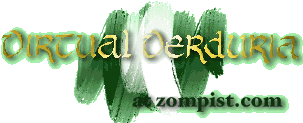



Bārumemaniciu 'giant' = Mountain Power.
Mavordaguendu = Iron Bender
Ecrêsetomurgo = Growing StoneThe names of the Giants are neuter, since they are neither male nor female.
Sillêlicu = Lightbed-- that is, where the sun sleeps. This is the highest peak in the Eresso Mountains, and thus the last point to be illuminated at sunset.
We have no good evidence that Giants existed in historical times, and we cannot make archeological excavations. Other Almean peoples also tell stories of the Giants, but these could still be independent inventions. It's certainly possible that the Giants are an extinct intelligent species.
As in terrestrial legends, the Giants aren't described using a fixed scale. One runs down a mountain, but later is tall enough to reach the moons; at one point the trees are knee-high to a Giant, at another the trees are like grass underfoot. In other folklore, a Giant can sit inside an iliu's house, though his head pushes against the ceiling.
The first Giant was created on Mount Sillêlicu, on the western border of Cuzei, and his first action was to run down to the Isrēica (V. Eärdur). Even Cuzeian prehistory happened in Eretald.
To Mavordaguendu's discussion with the Eīnalandāue, Anacūlato added a theological note:
This is how creation works; there is not one excellence, but many types. The unconfined intelligence of the First Spirits is a great thing, but for spirits to live in matter and take delight in sensation and movement is also a great thing.
As with all words in the text, the Giantish words are approximated to the Cuêzi sound system. As this is about our only source on Giantish, it isn't known if these words correspond to a 'real language' or not. Note that the word for 'water' is full of fricatives and high vowels-- to Cuzeian ears it sounds very watery. The word for 'ground', by contrast, is full of nasal stops and back vowels.
The order the Giants followed in inventing their language (nouns, attributes, actions) is also the order of presentation in Cuziean and Caďinorian grammatical tradition-- and philosophy.
Some Cuzeian writers took this passage to mean that thought is universal: all spirits communicate in the same 'language of God' (misseca nūmiore). This primordial language became a fascination for mystics and magicians.
The story of the creation of language solves something of a narrative puzzle: what stories can be told of a people who don't know either sin or sex?
The order of creation involves a steady progression, from beings much like Iáinos, to beings more like humans. The Giants are the first beings of flesh (albeit flesh harder than rock); but their innocence of sex and evil makes them still quite different from humans.
Soxāeco (V. Škagon) is of uncertain origin.
Ogres = Gauminiū, named for the Gaumê (V. Ctelm) mountains. Gaumê is from Meťaiun Gauťmene 'Hills of Dawn'; not remembering this, the Cuzeians reversed the derviation, believing that the mountains were named after the ogres.
Bōexurgo = big son of clay.
The last few lines of the poem state a major theme of many of the Cuzeian prophets: the particular shame of a Cuzeian Lord who oppresses his own people. These prophets were usually persecuted in their lifetime, and revered afterward.
Even in ancient times there were wiseacres who asked, if the Eresso mountains were created by the Giants, how could Mavordaguendu have been created on Mount Sillêlicu? The Knowers answered that this mountain had been created by Eīledan.
Even Soxāeco finds it impossible to completely control the ogres, and they seem to have a stubborn sense of honor. Some scholars have suggested that their character is based on that of the Western barbarians, the Somoyi-Meťelyi, who were admired as noble and brave though irremediably violent warriors. (We will not be able to fully evaluate this suggestion until Eteodäole sources are available.)
Ktuvoks have never been idealized or tamed in Almean culture (as, for instance, wild animals and strong warriors are used as totems or to name sports teams). However, this has happened to the ogres to some extent-- no doubt because they're seen as a merely historical threat. (The Count of Years says that all the Ogres perished; a few do show up in later folklore when an immensely strong monster was needed.)


